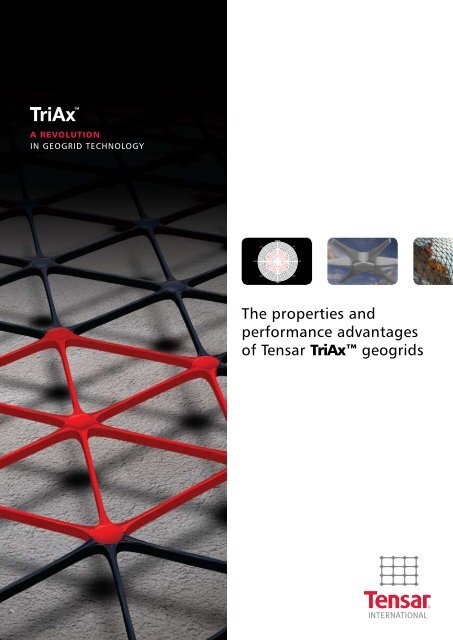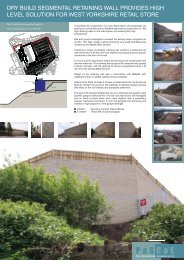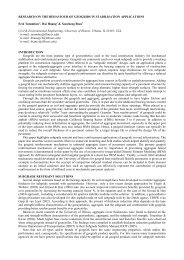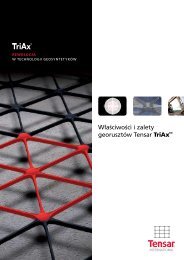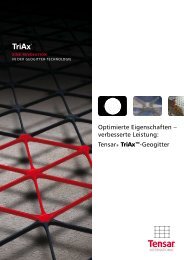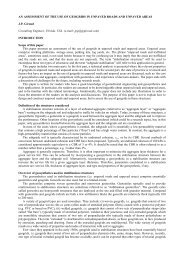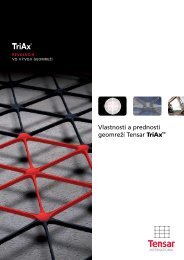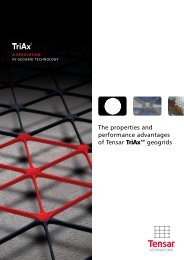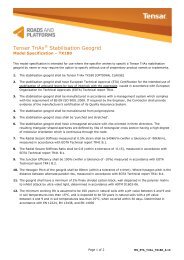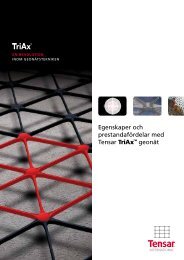Tensar TriAx Brochure
Tensar TriAx Brochure
Tensar TriAx Brochure
Create successful ePaper yourself
Turn your PDF publications into a flip-book with our unique Google optimized e-Paper software.
A REVOLUTION<br />
IN GEOGRID TECHNOLOGY<br />
TENSILE STIFFNESS FROM WIDE<br />
WIDTH TENSILE TEST<br />
360°/0°<br />
315°<br />
45°<br />
270°<br />
90°<br />
225°<br />
135°<br />
180°<br />
Minimum T ensar biaxial geogrid stiffness<br />
Minimum T ensar <strong>TriAx</strong> geogrid stiffness<br />
T ensar biaxial geogrid stiffness<br />
T ensar Tr iAx geogrid stiffness<br />
The properties and<br />
performance advantages<br />
of <strong>Tensar</strong> <strong>TriAx</strong> geogrids
A revolution IN GEOGRID TECHNOLOGY<br />
<strong>Tensar</strong> International has almost 30 years of experience in analysing and<br />
optimising the performance of geogrids. Drawing on this technical knowledge<br />
and expertise, <strong>Tensar</strong> has radically re-engineered the fundamental structure<br />
of geogrids to create a revolutionary new product. The <strong>TriAx</strong> geogrid is the<br />
culmination of this research and represents the future of geogrid technology,<br />
using one of the most stable forms – the triangular structure.<br />
2
Born From <strong>Tensar</strong> TECHNOLOGY<br />
<strong>TriAx</strong> gives improved aggregate confinement and interaction, leading to improved structural performance of the mechanical stabilised layer.<br />
<strong>Tensar</strong> invented and pioneered the original<br />
biaxial form of geogrid - until now the<br />
geogrid with the best performance in<br />
trafficked applications.<br />
Through <strong>Tensar</strong>’s policy of continual product<br />
development and innovation, the challenge<br />
for the <strong>Tensar</strong> development team was to<br />
improve on their biaxial geogrid and achieve<br />
even greater, long-term performance benefits.<br />
By examining all the design characteristics<br />
of the biaxial geogrid, through testing and<br />
research, the development team was able<br />
to identify the key areas that affect its<br />
performance. These are the profile of the<br />
rib section, rib thickness, junction efficiency,<br />
aperture size and, of particular importance,<br />
in-plane stiffness. This research evolved into<br />
a revolutionary change from a rectangular to<br />
a triangular grid aperture. This fundamental<br />
change to the grid structure, coupled with an<br />
increase in rib thickness and junction<br />
efficiency, gives greatly improved aggregate<br />
confinement and interaction, leading to<br />
improved structural performance of the<br />
mechanically stabilised layer.<br />
This was a revolution in geogrid technology<br />
with significant, new and improved benefits<br />
over the biaxial geogrid. A series of rigorous<br />
tests followed comparing the functional<br />
performance of <strong>TriAx</strong> with <strong>Tensar</strong> biaxial grids.<br />
These tests confirmed the research effort and<br />
demonstrated that <strong>TriAx</strong> functionally<br />
out-performed <strong>Tensar</strong>’s best performing<br />
biaxial geogrids.<br />
3
THE ADVANTAGES<br />
OF TRIAX GEOGRIDS COMPARED WITH BIAXIAL<br />
The unique <strong>TriAx</strong> structure incorporates several characteristics which combine to create an optimised<br />
structure that out-performs <strong>Tensar</strong> biaxial geogrids in trafficking applications. When combined<br />
with a suitable aggregate <strong>TriAx</strong> produces a mechanically stabilised layer with exceptional performance.<br />
LOAD DISTRIBUTION<br />
Load distribution is 3-dimensional in nature and acts radially at all levels in the aggregate.<br />
For a stabilised layer to be effective it must have the ability to distribute load through<br />
360 degrees. To ensure optimum performance, the geogrid reinforcement in a mechanically<br />
stabilised layer should have a high radial stiffness throughout the full 360 degrees.<br />
Load distribution<br />
acts radially.<br />
Junction integrity<br />
<strong>TriAx</strong> is produced from an extruded sheet of<br />
polypropylene. This is then punched with an<br />
array of holes and stretched to create the unique<br />
<strong>TriAx</strong> structure. This <strong>Tensar</strong> process, coupled with<br />
the design of the junctions, results in a product<br />
with high junction strength and stiffness.<br />
Junction efficiency<br />
Rigorous testing has been conducted in<br />
line with each of the three rib directions.<br />
In each direction tested, the <strong>TriAx</strong> geogrid was<br />
found to have high strength junctions and stiff<br />
ribs providing effective mechanical interlock of<br />
360°/0°<br />
aggregate particles into the aperture.<br />
Multi-directional properties<br />
315°<br />
360°/0°<br />
45°<br />
Biaxial geogrids have tensile stiffness<br />
315°<br />
45°<br />
predominantly in two directions. <strong>TriAx</strong><br />
geogrids have three principal directions of<br />
stiffness, which is further enhanced by their<br />
270°<br />
270°<br />
90°<br />
90°<br />
rigid triangular geometry. This produces a<br />
significantly different structure than any other<br />
geogrid and provides near-uniform stiffness<br />
through 360 degrees. A truly multi-directional<br />
product with near isotropic properties.<br />
The minimum radial stiffness for each product<br />
can be obtained from the relevant <strong>Tensar</strong><br />
product technical note.<br />
225°<br />
225°<br />
180°<br />
135°<br />
135°<br />
Minimum <strong>Tensar</strong> biaxial geogrid stiffness<br />
Minimum <strong>Tensar</strong> <strong>TriAx</strong><br />
<strong>TriAx</strong><br />
geogrid<br />
geogrid<br />
stiffness<br />
stiffness<br />
<strong>Tensar</strong> biaxial geogrid stiffness<br />
<strong>Tensar</strong> biaxial geogrid stiffness<br />
<strong>Tensar</strong> <strong>TriAx</strong> geogrid stiffness<br />
<strong>Tensar</strong> <strong>TriAx</strong> geogrid stiffness<br />
The polar diagram shows the shape of tensile<br />
stiffness plots for <strong>Tensar</strong> biaxial and <strong>TriAx</strong> geogrids<br />
manufactured from the same sheet thickness, with<br />
<strong>TriAx</strong> exhibiting near-isotropic properties.<br />
Node structure providing high junction efficiency.<br />
4
GEOGRIDS<br />
Greater interlock AND<br />
confinement<br />
In a mechanically stabilised layer, aggregate<br />
particles interlock within the geogrid and are<br />
confined within the apertures, creating an<br />
Aggregate confinement within a mechanically stabilised layer.<br />
Compared with <strong>Tensar</strong> biaxial geogrid, <strong>TriAx</strong> increases the magnitude of<br />
confinement and increases the depth of the confined zones.<br />
Unconfined zone<br />
enhanced composite material with improved<br />
performance characteristics. The structural<br />
properties of the mechanically stabilised<br />
layer are influenced by the magnitude and<br />
Transition zone<br />
(Partial confinement)<br />
depth of the confined zones.<br />
The shape and thickness of the geogrid ribs<br />
and the overall structure of <strong>TriAx</strong> has a direct<br />
influence on the degree of confinement and<br />
efficiency of the stabilised layer.<br />
Magnitude of confinement<br />
Fully confined<br />
zone<br />
<strong>TriAx</strong> geogrid<br />
<strong>TriAx</strong> rib structure directly influences the efficiency of<br />
the stabilised layer.<br />
Proving the importance of<br />
rib profile<br />
Compared with <strong>Tensar</strong> biaxial geogrid, <strong>TriAx</strong><br />
geogrid has a more efficient rib profile.<br />
Trafficking tests and analytical modelling<br />
were undertaken to investigate the influence<br />
of rib profile on performance. The results<br />
were conclusive in confirming the<br />
importance of a combination of the depth<br />
and shape of the rib profile. Deep profile ribs<br />
are more effective than thin profile ribs and<br />
a rectangular profile is more effective than a<br />
rounded profile. <strong>TriAx</strong> has been engineered<br />
to provide the most efficient use of material.<br />
The ribs have an optimised, high depth to<br />
width ratio and a rectangular, slightly<br />
concave edge profile.<br />
<strong>TriAx</strong><br />
<strong>Tensar</strong> biaxial<br />
Compared with <strong>Tensar</strong> biaxial geogrid, <strong>TriAx</strong> geogrid<br />
has a more efficient rib profile.<br />
Sustainable Design<br />
The improved performance of <strong>TriAx</strong> geogrid<br />
enables greater reductions in aggregate layer<br />
thickness, further reducing the quantities of<br />
natural aggregates used and the volume of<br />
material to be excavated. These additional<br />
savings in materials and transport will help<br />
engineers to meet their sustainability objectives.<br />
5
Scientifically proven<br />
TRIAX outperformS EVEN TENSAR BIAXIAL geogrids<br />
A number of tests and trials have been conducted to prove the performance benefits of the <strong>TriAx</strong><br />
geogrid compared with <strong>Tensar</strong> biaxial geogrids. Tests included trafficking trials at the University<br />
of Nottingham and, on a large scale, at the Transport Research Laboratory (TRL). Installation damage<br />
assessment, bearing capacity and field tests were also conducted as part of the comprehensive and<br />
rigorous testing programme.<br />
THE University OF NOTTINGHAM<br />
trafficking Test facility<br />
Facilities at the Nottingham Transportation<br />
Engineering Centre (NTEC) at the University<br />
of Nottingham were used to identify the<br />
design features required for improved<br />
performance and to help shape and define<br />
the <strong>TriAx</strong> geogrid. The trafficking test facility<br />
at NTEC was used to produce a large quantity<br />
of trafficking data across both <strong>TriAx</strong> and<br />
<strong>Tensar</strong> biaxial geogrids, confirming the much<br />
improved performance benefits of<br />
the <strong>TriAx</strong> geogrids compared with <strong>Tensar</strong><br />
TRL trafficking trials<br />
biaxial geogrids.<br />
INCREASING DEFORMATION<br />
The performance advantage<br />
of <strong>TriAx</strong> compared with<br />
<strong>Tensar</strong> biaxial geogrids has<br />
been tested and proven in<br />
trafficking trials at TRL.<br />
<strong>Tensar</strong> <strong>TriAx</strong> geogrid<br />
Testing at NTEC produced a large quantity of<br />
trafficking data, confirming the much improved<br />
performance of the <strong>TriAx</strong> geogrid.<br />
TRAFFIC LOADING<br />
(number of wheel passes)<br />
<strong>Tensar</strong> biaxial geogrid<br />
Trafficking trials were conducted on a<br />
much larger scale at the Transport Research<br />
Laboratory in the UK. A large number of <strong>TriAx</strong><br />
and <strong>Tensar</strong> biaxial geogrids were tested across<br />
varying aggregate depths – each up to 10,000<br />
passes. The results showed that wheel track<br />
deformations were consistently smaller for<br />
<strong>TriAx</strong> geogrids and proved conclusively the<br />
structural benefits of <strong>TriAx</strong>, which include:<br />
• Improved confinement of aggregate and<br />
enhanced performance of a mechanically<br />
stabilised layer<br />
• An increase in traffic life for a given<br />
sub-base thickness<br />
• A reduction in sub-base thickness for a<br />
given traffic load<br />
The effect of geogrid aperture size, shape and rib<br />
depth was extensively researched at NTEC.<br />
6
Trafficking trials by TRL proved the performance benefits of the <strong>TriAx</strong> geogrid compared with <strong>Tensar</strong> biaxial geogrids.<br />
Installation damage assessment<br />
Additional tests conducted at the TRL were<br />
to establish how the <strong>TriAx</strong> geogrid would<br />
withstand a typical installation procedure and<br />
full compaction. <strong>TriAx</strong> geogrid proved tough<br />
enough to cope without loss of integrity to<br />
Installation and handling<br />
The final aspect of performance is handling<br />
on-site. Extensive use in projects covering a<br />
range of applications have now proved that<br />
<strong>TriAx</strong> is easy to handle and is robust and tough<br />
enough to be installed over weak sub-grades.<br />
the overall structure.<br />
Multi-directional trafficking<br />
performance<br />
The near isotropic stiffness properties of<br />
<strong>TriAx</strong> geogrid suggests that the product will<br />
perform consistently well, regardless of the<br />
wheel path direction. This has been confirmed<br />
by multi-directional trafficking tests in the<br />
NTEC slab test facility comparing <strong>TriAx</strong> with<br />
<strong>Tensar</strong> biaxial geogrids.<br />
Deformation measurements showed that<br />
<strong>TriAx</strong> geogrid performed equally well in all<br />
trafficking directions. This is in contrast with<br />
<strong>Tensar</strong> biaxial geogrids, which showed a<br />
reduced effectiveness when trafficked at an<br />
orientation of 45 degrees to the rib direction,<br />
against comparable trafficking parallel to the<br />
rib direction.<br />
Excavation of <strong>TriAx</strong> for installation damage<br />
assessment at TRL.<br />
Bearing capacity improvement<br />
Large scale bearing capacity tests conducted<br />
by the UK Building Research Establishment<br />
(BRE) have shown that the increased stiffness<br />
and confinement provided by <strong>TriAx</strong> results in<br />
even greater load distribution capacity than<br />
<strong>Tensar</strong> biaxial geogrids.<br />
<strong>TriAx</strong> geogrid can be handled by machine or carried<br />
manually.<br />
<strong>TriAx</strong> geogrid unrolled on site.<br />
Aggregate placed over <strong>TriAx</strong> geogrid prior to full<br />
compaction.<br />
Bearing capacity tests at BRE confirm <strong>TriAx</strong> geogrids<br />
increase load distribution.<br />
7
ADVANCED TECHNOLOGY<br />
SUPERIOR TECHNICAL SUPPORT<br />
Even the most technologically superior products are unlikely to<br />
perform to their maximum potential without the accompaniment<br />
of expertise and experienced support.<br />
<strong>Tensar</strong> <strong>TriAx</strong> geogrids are supplied with the support of <strong>Tensar</strong><br />
Technology - high performance products backed up by the knowledge<br />
and know-how to get optimum results. The Technical team at <strong>Tensar</strong><br />
are world-renowned for unrivalled knowledge and expertise, providing<br />
engineers and contractors on request with the reassurance of design,<br />
technical and installation guidance on all projects.<br />
<strong>Tensar</strong> <strong>TriAx</strong> geogrids are supplied with the support<br />
of <strong>Tensar</strong> Technology.<br />
<strong>Tensar</strong>Pave TM design software<br />
<strong>Tensar</strong>Pave TM is a software package developed<br />
by <strong>Tensar</strong> International, incorporating <strong>TriAx</strong><br />
design parameters for the most economical<br />
ground stabilisation and pavement design<br />
solutions.<br />
Designing with <strong>TriAx</strong> geogrids<br />
To get the best from <strong>TriAx</strong> and arrive at the<br />
most cost-effective designs for your client,<br />
<strong>Tensar</strong>Pave TM software is available free of<br />
charge with specific user training from<br />
<strong>Tensar</strong> International.<br />
8
TENSAR PROVIDES<br />
SUPERIOR SUPPORT FOR...<br />
...design engineers<br />
<strong>Tensar</strong> International’s design team can<br />
offer free applications suggestions and<br />
indemnified designs, with full working<br />
drawings, offering increased support to<br />
design engineers.<br />
...groundwork specialists<br />
Initial installation advice and specialist advice<br />
on dealing with difficult ground conditions<br />
are available from our experienced technical<br />
support team. In cases involving extreme soil<br />
conditions, it is often the method of working<br />
that is the difference between a profitable<br />
...contractors<br />
The additional aggregate reductions made<br />
possible by <strong>TriAx</strong> geogrid may be the saving<br />
you need to give you a competitive edge<br />
and win that contract. Working to tight<br />
deadlines, <strong>Tensar</strong> engineers can provide a<br />
fully costed, alternative design. For projects<br />
on-site, our engineers are available on<br />
request to advise on solutions for problems<br />
with construction over weak or variable<br />
ground. <strong>TriAx</strong> geogrids are available from a<br />
network of distributors able to deliver locally<br />
from stock.<br />
project and a poor outcome. Our support team<br />
offers the knowledge to make the difference.<br />
...piling contractors<br />
Working platforms for piling or crane access<br />
are an essential but costly item for access over<br />
poor ground. <strong>Tensar</strong> International can provide<br />
an indemnified design and supply solution,<br />
subject to conditions, for working platforms<br />
that take full advantage of <strong>TriAx</strong> geogrids to<br />
minimise platform thickness and costs.<br />
<strong>TriAx</strong> geogrid represents the future of<br />
geogrid technology.<br />
<strong>TriAx</strong> geogrid is easy to handle.<br />
...housebuilders<br />
<strong>TriAx</strong> geogrid is on hand to increase your<br />
opportunities to minimise costs and<br />
maximise profits. Upon encountering<br />
soft ground problems or brownfield sites<br />
subject to differential settlement, <strong>Tensar</strong>’s<br />
experienced engineers are available to<br />
offer solutions on-site and identify further<br />
opportunities to save you time and money.<br />
Our engineers can provide alternative<br />
options, whether it is through applications<br />
suggestions or indemnified designs,<br />
complete with working drawings and<br />
support to obtain any necessary approval.<br />
<strong>Tensar</strong> are world-renowned for unrivalled knowledge<br />
and expertise.<br />
Delivering the best performance in trafficked<br />
applications.<br />
<strong>TriAx</strong> geogrids are available from stock.<br />
<strong>Tensar</strong> provides contractors with design,<br />
technical and installation guidance.<br />
9
APPLICATIONS<br />
<strong>TriAx</strong> TM geogrids from <strong>Tensar</strong> International offer exceptional performance in ground stabilisation and sub-base<br />
reinforcement. Combined with the technical support and expertise offered by the <strong>Tensar</strong> team, <strong>TriAx</strong> TM<br />
represents<br />
the future of geogrid technology and, with its proven performance, will replace conventional biaxial geogrids.<br />
Roads and trafficked areas<br />
With <strong>TriAx</strong>geogrid and its structural<br />
performance benefits, there is an opportunity<br />
to make considerable savings on unpaved<br />
roads and permanent road construction.<br />
helps engineers meet sustainability<br />
objectives. For thin surfaced pavements,<br />
<strong>TriAx</strong>geogrids can provide longer-term<br />
benefits, with an increase in pavement life<br />
and reduction in whole life costs.<br />
By providing a reinforced sub-structure to<br />
a road pavement, <strong>TriAx</strong>geogrids can be used<br />
to help control differential settlement and<br />
offer cost savings of up to 75% compared<br />
with conventional solutions.<br />
Less aggregate is required with <strong>TriAx</strong><br />
geogrid, which can also reduce installation<br />
time and further helps to reduce ground<br />
stabilisation costs. The reduction in<br />
aggregate materials and transport also<br />
HOUSING<br />
Increasingly, housing developments are being<br />
built on weak or marginal land. This means<br />
that the sub-grade conditions can be variable,<br />
which leads to differential settlement.<br />
All geogrid applications require<br />
appropriate engineering analysis by<br />
<strong>Tensar</strong> Design Engineers or other qualified<br />
professional engineers.<br />
Many millions of square metres of <strong>Tensar</strong> <strong>TriAx</strong> TM geogrid are in use around the world and have been<br />
installed on a wide variety of projects.<br />
Case study 1<br />
Arecleoch Wind Farm, Scotland<br />
<strong>Tensar</strong> <strong>TriAx</strong> geogrids were the answer<br />
for a new Scottish wind farm built in a rural<br />
area. Existing tracks had to be widened and<br />
new access roads built over the site which had<br />
low ground strength with CBR values between<br />
0.5% and 1%. Using thick stone layers to<br />
accommodate site traffic would have involved<br />
large numbers of vehicle movements and<br />
excessive road settlement. Instead, multiple<br />
<strong>Tensar</strong> <strong>TriAx</strong>geogrid layers were installed and<br />
combined with site-won stone. Although the<br />
stone quality was less than ideal, this solution<br />
delivered excellent trafficking performance and<br />
achieved a 15% carbon emissions saving over<br />
an unreinforced solution.<br />
10
Online Carbon Calculator<br />
Check your carbon footprint and realize the environmental benefits with<br />
cost savings for your project, online at www.tensarsustain.co.uk<br />
Case study 2<br />
Green Point Stadium, Cape Town, South Africa<br />
<strong>TriAx</strong> helped create significant time and<br />
cost savings for the new Cape Town World<br />
Cup stadium, where extensive earthworks<br />
had generated large quantities of variable<br />
quality loose fill. In one area this fill was used<br />
as a temporary haul road ramp. This needed<br />
converting into a permanent heavy-duty<br />
road, but was showing signs of deformation.<br />
With no time to excavate and re-compact<br />
the fill material, two layers of <strong>Tensar</strong> <strong>TriAx</strong><br />
were added to the sub- base. This stabilised<br />
the ramp and minimised any differential<br />
settlement. <strong>TriAx</strong> was used to reinforce the<br />
haul road, the surface of which would later<br />
be trimmed to form the foundation for the<br />
permanent road, also stabilised by the<br />
same geogrids.<br />
Case study 3<br />
Flooding of River Derwent, Cumbria, England<br />
<strong>TriAx</strong> geogrid helped build a new<br />
crossing over the River Derwent when floods<br />
destroyed existing bridges in Workington.<br />
<strong>Tensar</strong> International helped design the new<br />
bridge abutments and an assembly platform.<br />
It also delivered the required <strong>TriAx</strong> the next<br />
day so that work could start immediately.<br />
Constructing abutment bank seat supports<br />
from aggregate, mechanically stabilised with<br />
multiple layers of <strong>TriAx</strong> reduced the need for<br />
piling or deep foundations. The use of <strong>TriAx</strong><br />
also meant that the geogrid construction<br />
immediately became load bearing (with no<br />
concrete setting time required) allowing the<br />
bridge deck to be rapidly installed.<br />
Photography courtesy of www.jackthehat.co.uk<br />
<strong>TriAx</strong> represents the future of geogrid technology, replacing<br />
conventional biaxial geogrids.<br />
11
Your local distributor is:<br />
Q 05288<br />
ISO 9001:2008<br />
EMS 86463<br />
ISO 14001:2004<br />
©Copyright <strong>Tensar</strong> International Limited.<br />
The information in this brochure is supplied by <strong>Tensar</strong> International free of charge. <strong>Tensar</strong><br />
International do not assume any duty of care to you or any third party. No liability for negligence<br />
(other than for death and personal injury) can arise from any use of or reliance on the information<br />
in this brochure or use of any <strong>Tensar</strong> International product mentioned. <strong>Tensar</strong> International will not<br />
be liable if this brochure contains any misrepresentation or misstatement. Determination of the<br />
suitability for any project of the information and any <strong>Tensar</strong> International product mentioned in it<br />
must be made by your engineer or other professional advisor who has full knowledge of the<br />
project. You, together with any such engineer or advisor, must assume all risk of loss and damage<br />
of any kind arising from use of the information or any product of <strong>Tensar</strong> International other than<br />
the risk of death and personal injury. If you or any third party subsequently purchases a product<br />
referred to in this brochure or any other <strong>Tensar</strong> International product the entire terms of the<br />
contract of purchase and the entire obligation of <strong>Tensar</strong> International relating to the product or<br />
arising from its use shall be as set out in <strong>Tensar</strong> International’s Standard Conditions in force at the<br />
time of purchase, a copy of which may be requested from <strong>Tensar</strong> International.<br />
<strong>Tensar</strong>, <strong>TriAx</strong> and <strong>Tensar</strong>Pave are trade marks of <strong>Tensar</strong> International Limited.<br />
February 2010 - issue 7<br />
11/02/10 SLG13001<br />
<strong>Tensar</strong> International Limited<br />
Cunningham Court<br />
Shadsworth Business Park<br />
Blackburn<br />
BB1 2QX<br />
United Kingdom<br />
Tel: +44 (0)1254 266990<br />
Fax: +44 (0)1254 266868<br />
triax@tensar.co.uk<br />
www.tensar-triax.co.uk


